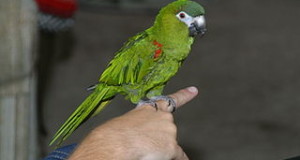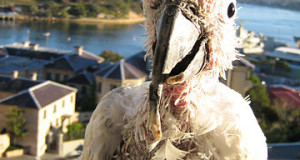Please see Part I of this article for information on related health concerns.
Feather Cysts
Feather cysts form when feathers growing below the bird’s skin fail to emerge properly. They then curl back and continue to grow, forming elongated lumps at the base of one or several feathers. Secondary bacterial infection may set in, exacerbating the problem.
Feather cysts usually form at the base of the primary wing feathers, and are most commonly seen in budgerigars, canaries and macaws. They should be surgically removed by a veterinarian.
Swellings near the Cloaca
A swollen area just above the cloaca (the common opening for the digestive and respiratory systems in birds) is often indicative of a hernia. Usually related to stomach muscle atrophy, hernias are difficult to treat and require veterinary intervention.
Swellings below the cloaca may also indicate a hernia or, more commonly, a tumor. Egg-bound hen budgerigars and other birds will also appear swollen in this area, and may strain in an attempt to dispel the egg. Immediate veterinary attention is necessary.
Further Reading
Please check out the book Parakeets: a Complete Pet Owner’s Manuel for more information on parakeet care.
Image referenced from morguefile and originally posted by eviljeff.
 That Bird Blog – Bird Care and History for Pet Birds
That Bird Blog – Bird Care and History for Pet Birds




My canary has a huge transparent air bubble with a few tiny dots inside above his right shoulder. What could be the cause of this and what can I do about it? Thank you
Hello, Frank Indiviglio here.
Thanks for your interest in our blog.
You’ll need to keep the bird calm so that it does not injure the area or cut it against the cage bars and have it examined by a veterinarian as soon as possible…unfortunately, this is not a condition that you can diagnose or treat at home. Transporting the bird will be tricky – covering the cage and moving very slowly while carrying it is likely your best option.
Good luck and please let me know if you need assistance in locating an avian veterinarian.
Best regards, Frank Indiviglio.
hi frank my cannary has a very swollen eye she has had antibiotics but looks even worse any idea what it could be
Hello Helen, Frank Indiviglio here.
Thanks for your interest in our blog. A worsening of the condition despite antibiotics can be the result of any number of factors; unfortunately, there really is no way to diagnose the problem without a return visit to your vet. Sometimes medications must be changed, because the pathogen involved is not sensitive to antibiotic being used; secondary infections can also arise a s a result of a weakened immune system. The is always a chance that trauma was involved, by I assume your vet ruled that out during the first exam.
Sorry I could not be more specific, but a vet visit is your best option – infections can worsen very quickly, so you should attend to this ASAP.
Good luck and please keep me posted.
Best regards, Frank Indiviglio.
Hi!I have a canary with very swollen eye.I’m from greece and i don’t know why but i couldn’t find any avian vets here and nobody can tell me what is wrong with my canary.I hope that someone here will have answer for me.My bird has swollen eye(somethimes is more swollen and sometimes less but it’s like this for a long time,longer than a year,because i can’t find anybody who knows what to do with it).I can’t say that the eye is red,it actually looks like there is something white under the skin,but i have never seen a pus or something like that to come out.only the right eye is like this and there almost no feathers around the eye.except this problem my bird is eating well,taking a bath and everything else-everything is normally.i will be very happy and grateful if you can help me
Hello Michaela, Frank Indiviglio here.
Thanks for your interest in our blog. I checked the Association of Avian Veterinarians, and also could not find a listing for Greece; here is the link – perhaps someone in a neighboring country can recommend a colleague in Greece. Poultry associations, if such are located there, are another option for referrals to an avian vet.
Fortunately, a severe infection is not present, or the bird would not have survived for so long. However, the strain of battling the problem is taxing to the immune system, so treatment by a vet is the best option. Unfortunately, there is really no way to diagnose the ailment without a vet exam.
Good luck and please keep me posted.
Best regards, Frank Indiviglio.
Thank you so much for answering me so soon Frank!
Hello Michaela, Frank Indiviglio here.
Thanks for the note; my pleasure. I hope you’re able to find a vet…please keep me posted and feel free to write other comments or questions.
Good luck,
Best regards, Frank Indiviglio.
Swollen anal area. fluffed and sleepy, fecal matter mated around area. Wiped with wet q tip and some fecal matter oozed out. Help
Hello Keith, Frank Indiviglio here.
Thanks for your interest in our blog. What you describe can be symptomatic of a very wide array of problems – egg retention, bacterial/viral infection and so on. This is not something that you can take care of at home. Infections spread very rapidly in birds and can be fatal in a very short time. It is imperative that you get the bird to a vet ASAP; keep it warm, using a small incandescent bulb if need be, until then. Please let me know if you need assistance in locating an avian vet.
Please let me know if you need any further information. Good luck and please keep me posted.
Best regards, Frank Indiviglio.
My canary has a swollen,reddish leg.It tucks the afflicted leg up ,standing on the other only.|it seems to be eating normally . Can you tell me what I can do to relieve the pain?
Hello Suji, Frank Indiviglio here.
Thanks for your interest. Unfortunately, it’s not possible to diagnose the problem without a vet visit. This should be done soon, as any infection that may be present will spread quickly. Keeping the bird warm and as calm as possible is important until you see the vet. Be sure to work slowly near the bird for now, so that it does not move about and injure the leg further.
Please let me know if you need any further information. Good luck and please keep me posted.
Best regards, Frank Indiviglio.
Hi,
I bought my yellow canary from a small local pet shop.
Within a couple of months i noticed one side of the breast was larger, took the bird to the vet who told me he had a tumor. I had the tumor removed and now, a couple of months later, he has another one.
He cannot stand on his leg, instead he tucks it up and leans on one leg. Sometimes he will bite the foot he cannot lean on. The lump is on the top of his breast.
Is this likely to be a recurring thing or can the tumors be stopped?
What should i do in the mean time before i can take him to the vet?
Thank you
Hello Lacey, Frank Indiviglio here.
Thanks for your interest. Unfortunately, tumors can be a recurring problem when caused by certain cancers, or for other reasons, much as in other animals and people.
It would be best to keep the bird as quiet as possible until you see your vet; perhaps cover the cage, so as to limit the possibility that the bird will move about and further stress the leg and body in general. Sorry I cannot provide a more helpful answer, but we still have a great deal to learn about avian tumors.
Please let me know if you need any further information.
Best regards, Frank Indiviglio.
Hi! I have a canary a couple months old. A couple weeks ago it had a lump next to its eye that looked like a seed. After a few days the lump grew bigger and bigger and a few days after that it disappeared. Now there is a similar lump on its wing. What should I do?
Hello Inez,
Those symptoms can be caused by a number of different underlying conditions…a vet exam is necessary for diagnosis. please let me know if you need help in locating an avian veterinarian.
best regards, frank
I purchased a green and yellow canary a few months ago, he was doing fine singing etc. so it is a male. I noticed something near his tail feathers, which are curly. It looked like yellowish dried fecal matter. I proceeded to wash-soften it to remove it but noticed it had a swollen round tumor, there is also another spot of this dry hard fecal looking stuff it is not at vent but, close. tail feather area. What could this be?, or what could be causing it? Thank-You!
Hello Donna,
Unfortunately it’s not possible to diagnose the problem via appearance alone…a vet exam is necessary. I hope all goes well, Frank
My bird ‘s wings have been cut before I bought him and could of never been able to fly since then.. It’s been years.. And he has feel here and there .. Well a few weeks ago he feel from the table and hurt his wing pretty bad … And now I realized that his left wing is formed into a huge ball… It looks like its been getting worse .. What do you think it is ?? I’m really concerned.. I’m really attached to this bird.. He is a Monk Parraket a little older than 5 to 6 years
From the sounds of it, it could very well be a feather cyst which can occur at the follicle due to trauma as you described. Your best course of action would be to take your bird to a vet, as most cysts need to be surgically removed. To prevent future cysts from forming, several bird owners believe that an increase in amino acids (oranges, broccoli, peas, etc) has helped them.